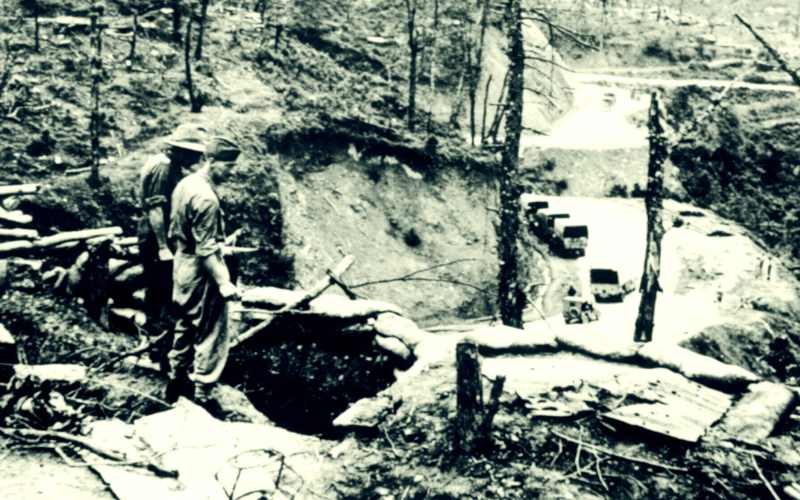
World War II : Battle for Kohima's Strategic Ridge
The Axis Gambit
The Japanese recognized the strategic importance of Kohima and the surrounding terrain. Under Operation U-Go, their objective was clear: to break through the rugged hills of Nagaland and swiftly advance to Dimapur on the plains. By seizing control of Dimapur, the Japanese aimed to sever Allied communication lines to China and pave the way for a full-scale assault on British India.
The success of Operation U-Go would have had far-reaching implications, potentially opening the entirety of India to Axis domination. The stakes were high, with the outcome of the battle poised to shape the course of the Burma Campaign and the broader theatre of war in the region. Kohima stood as a crucial linchpin in the struggle for control over Southeast Asia, its fate intertwined with the destiny of nations and the course of history.
The Battle of Kohima
Fought from April 4 to June 22, 1944, during World War II, it was one of the most critical and decisive engagements in the Burma Campaign. It took place in and around the town of Kohima, located in present-day Nagaland, India, and was part of the larger Battle of Imphal.
The
Battle of Kohima pitted the British and Indian forces, primarily from the 2nd
British Division and the 2nd Indian Division, against the Japanese forces of
the 31st Division under Lieutenant General Kotoku Sato. The Japanese
objective was to capture Kohima and cut off the Allied supply lines to Imphal,
thereby forcing the British and Indian forces to withdraw from eastern India.
The Japanese launched a surprise attack on Kohima on April 4, 1944, and quickly captured key positions around the town, including the Deputy Commissioner's bungalow, which became a focal point of intense fighting. Despite being heavily outnumbered and surrounded by Japanese forces, the defenders, led by Lieutenant Colonel Hugh Richards, held out against repeated Japanese assaults for several days. The British and Indian defenders were initially pushed back but managed to hold onto the vital Kohima Ridge, which overlooked the town.
The Japanese forces laid siege to the Allied defenders on Kohima Ridge, subjecting them to relentless artillery bombardment and infantry assaults. The defenders, entrenched in fortified positions, fought tenaciously to repel the Japanese assaults. The battle devolved into a brutal and protracted stalemate, with both sides suffering heavy casualties.
The turnaround
By late April and early May, Allied reinforcements arrived, bolstering the besieged defenders. The Allied forces launched a series of coordinated counterattacks, gradually pushing the Japanese back from their positions around Kohima. Fierce close-quarters combat ensued as the Allies reclaimed lost ground.
The Allies' logistical and communications superiority was key. They had not only allowed the quick deployment of reinforcements from Dimapur but also the airlifting of the 5th Indian Division and its equipment from Arakan to Imphal in only two days.
During the battle, the Royal Air Force flew in nearly 19,000 tons of supplies and over 12,000 men and evacuated around 13,000 casualties. Continually supplied by air, the garrisons threw back the Japanese attacks in bitter close-quarter fighting until the relief forces reached them.
By mid-May British and Indian troops, supported by tanks and artillery, launched a final assault to drive the Japanese from Kohima. By June 22, the Japanese forces were decisively defeated, and Kohima was liberated from enemy control.
The
Battle of Kohima was a strategic victory for the Allies, as it halted the
Japanese advance into India and prevented the encirclement of the British and
Indian forces at Imphal. The battle also marked the first time in World War II
that a Japanese offensive into India was successfully repelled.
The
Battle of Kohima is remembered for its ferocity, endurance, and sacrifice. It
is often referred to as the "Stalingrad of the East" due to the
intensity of the fighting and its significance in turning the tide of the Burma
Campaign in favor of the Allies. The Kohima War Cemetery, where many of the
fallen soldiers are laid to rest, stands as a poignant reminder of the battle's
human cost and the bravery of those who fought and died there.
Disclaimer: The opinions expressed in this article are those of the author's. They do not purport to reflect the opinions or views of The Critical Script or its editor.

Newsletter!!!
Subscribe to our weekly Newsletter and stay tuned.

















Related Comments